As a shiatsu diploma student, it probably goes without saying that I’m a major fan of face-to-face Shiatsu treatments. Energetically, physically, spiritually, and emotionally, shiatsu makes me feel witnessed, connected, rebalanced on all levels, and keeps me in touch with myself. In fact, shiatsu was the first modality of energy work I ever experienced—and that treatment affected me so deeply that it became the first step on my path to self-actualization, and my eventually discovering my calling to be an energy worker and holistic practitioner!
But there are times when you just can’t get a full shiatsu when you SO need help with an immediate (or even long-term) issue. In these circumstances, working some relevant acupressure points is a super-effective tool to have at your disposal. And the great news is that it’s free—you just need your hands, and the knowledge of how to find those points.
To follow is a selection of really effective points, plus guidance on how to find them, and pictures of where they are; so that you’ll have your very own set of go-to acupressure points that you can use on a day-to-day basis, as and when the need occurs—or even share with your friends, family, co-workers, etc. The less you have to rely on a product from the pharmacy to manage your symptoms, the better for your health, as well as your savings!
1. Lung 1 (and 2) Central Residence and Cloud Gate
Symptoms: These two points are great for breathing problems, including catarrh on the chest, symptoms of respiratory infections, those times when you feel like you can’t catch your breath, or have a tight/full-feeling chest.
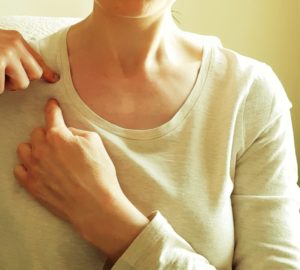
Lung 1 & 2
How to find them: These two points are either side of a little bone slightly below your collarbone, in line with the top edge and bottom edge of your first rib. When you find them, you’ll probably feel it right away– they’ll usually have a slightly tender feeling (which is the case with quite a few acupressure points, especially when they need work). So just tune into what your body’s telling you.
How to work them: With these two points, you can use relaxed fingers to gently press in, at 90 degrees to your body’s surface, and breathe normally or deeply. You could also use a percussive technique called “Do-In,” where you use loose gentle fists or fingertips to tap or knock the points as though you were knocking gently at a door (you will probably get both points at once, and that’s fine). Try vocalising an “aaaaaaaaaaah” sound whilst doing it—you should be able to hear the tapping, and also feel the effects more strongly in your chest and lungs.
2. Kidney 1: Bubbling Spring
Symptoms: I love this point, and I think you will too! It’s brilliant for a multitude of different problems, which may seem a little disparate at first glance, but in Traditional Chinese Medicine (TCM), they are all related to a need for more Yin. Yin deficiency is something which all of us can probably relate to. It’s that nurturing, self-caring, rest and digest-type mode that we all too often de-prioritize, to our own cost. Without making space for a little regular Yin time, we can end up exhausted but unable to rest properly, and feeling hot with night sweats. These symptoms are all classic indications of a Yin deficiency. The plethora of symptoms this point treats include things like
- Sore throat/sinusitis/earache/mouth ulcers
- Water retention/thrush
- Headache/migraine
- Agitation/high blood pressure/irritability
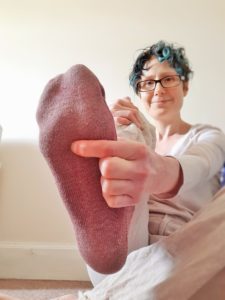
Kidney 1
How to find it:
Kidney 1 is on the soles of the feet. It’s a point that connects us to the earth with when we stand up, and when I work this point, I like to picture it bringing the Yin Energy up from the earth, into our body—reflected in the rather gorgeous name, which translates as “Bubbling Spring.”
You’ll find this point 1/3 of the way down each of your feet, nearest the toes, around the centre of the foot. If you flex your foot, you should be able to find a depression—that’s Kidney 1. It has a lovely, calming, reviving sort of feeling—sometimes it feels to me like a feeling of nurturing, permeating through my body. It works on all levels but it can be a bit like the emotional-level version of that sigh of relief sensation you get, when you sink into a lovely hot bubble bath, surrounded by scented candles, and a glass of your favorite wine just within easy reach…
How to work it:
Using a finger (index or middle), apply gentle perpendicular pressure to the point, and continue for about 10 minutes or until you feel like it’s done its job. I tend to position the foot on the ground with the hand holding the outer side of the foot, and the middle finger slightly bent, positioned in the point.
3. Stomach 25: Heaven’s Pivot
Symptoms: This point is good for digestive issues of most kinds, and some menstrual problems. It can be used to treat constipation, diarrhea, abdominal pain, gas, indigestion, late, irregular or absent periods.
How to find it: It’s located 3 fingers’ width to the side of your naval, and as there’s one on each side, you can work one or both at once.
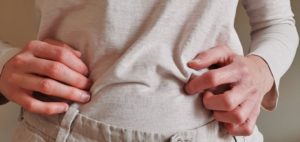
Stomach 25
How to work it: As there are no bony structures around here, and this is a delicate area, with lots of important organs, firm pressure isn’t advised. Instead, use a finger to gently locate the point, and hold very gentle pressure, with a relaxed finger. If you’re into spiritual stuff and energy yourself, you could try just touching the point, and imagine energy extending out of your finger, into your body. Lovely!
4. Heart Protector (aka Pericardium) 8: Palace of Labor
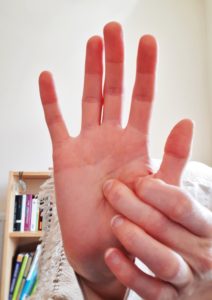
Heart Protector 8
Symptoms: This is very much an SOS acupressure point to give emotional support and calm the Heart. It’s very effective in times of emotional shock, anxiety or panic, stress or trauma, and can work to calm palpitations and treat chest pains. I feel like it brings a soothing, calming energy almost immediately you start to work it. It’s also good for angina, psychological disorders, nosebleed, mouth ulcers and delirium.
How to find it: HP 8 is located in the palm of your hand. If you fold your fingers down to touch your palm, you’ll find this point where the middle finger touches the palm.
How to work it: Simply apply pressure using a finger. One of the lovely things about this point is that you can work it subtly, in any situation, without anyone else noticing.
5. Stomach 44: Inner Courtyard
Symptoms: This is a great point for treating hangover symptoms—headache, painful eyes, burning indigestion, diarrhea, heartburn, hiccups and vomiting (fun fact: hiccups/vomiting are known as “Rebellious Qi” in TCM).
How to find it: On the foot, between the second and third toes, on the edge of the space between the toes, where the white and red skin (or upper and lower foot) meet.
How to work it: Apply gentle but firm perpendicular pressure with a finger.
6. Stomach 36: Leg Three Miles
Symptoms: One of those mythic and ridiculously effective points. This point, as legend would have it, was used by soldiers in ancient China, who were so exhausted they just couldn’t walk anymore. According to the story, it didn’t matter how exhausted or wounded the soldiers were, working this point for a few minutes gave them all a second burst of energy, and enough stamina to press on for the last crucial 3 miles. Impressive stuff, eh?!
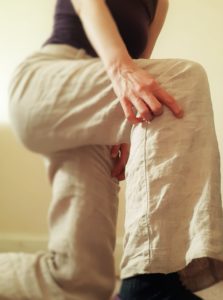
Stomach 36
Well, all legends and tales aside, Stomach 36 is a stupendously useful and important acupressure point. Its benefits include: fortifying the whole body, treating sleepiness, treating insomnia, stimulating the immune system, harmonizing your body’s energy or Qi, helping the digestive system to work better, knee problems, mental health problems, and pre-menstrual problems—to name but a few.
So next time you need a little bit of extra oomph, if you’re pulling an all-nighter to meet that important deadline, or are doing a charity marathon and just hit that brick wall—well, now you can whip Stomach 36 out of your holistic toolkit, and get your extra 3 miles’ worth from it!
How to find it:
Measure 4 fingers’-breadth from the knee, down the shin. It’s located in between the tibia and fibia bones, 1 fingers’ breadth from the tibial crest (the highest part of the inner bone). So in that space between the two bones.
How to work it: Press firmly with a strong finger or thumb—it should feel a little tender, but adjust your pressure if it feels properly painful. Hold the point until you feel the effects.
7. Spleen 10: Sea of Blood
Symptoms: Yes, that’s right—the poetic (some might say graphically descriptive) name of this point refers very directly to its main use: treating menstrual problems. This is good for menorrhagia (extremely heavy flow including breakthrough bleeding—often caused by something like fibroids), irregular menstruation, anaemia, soreness in the lower back, endometriosis, and also interestingly, skin problems like eczema and urticaria, as well as sciatica!
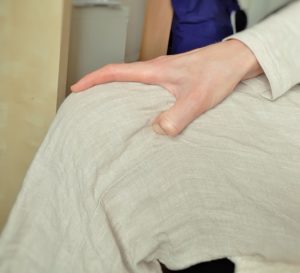
Spleen 10
How to find it: Find the spot about 3 fingers width above the top of the knee, then move from there around the leg, in the direction of the inner (lower) thigh. This point presses in against the thigh-bone. If you use your thumb to work the point, the rest of your hand can neatly cup the top of the knee.
How to work it: Use a thumb or finger, and apply firm, direct pressure. If you don’t feel a sensitive area that immediately jumps out in a “here I am” kind of way, then feel around. All bodies are different, and your point might need a slightly different angle for you to reach it, depending on how developed your muscles are, around there. Once you’ve found the point, just hold it for 10 or so minutes, or longer if your fingers will hold up for that long.
8. Liver 3: Great Surge
Warning – this point is contra-indicated in pregnancy
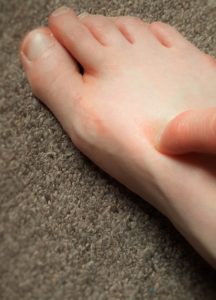
Liver 3 *Contra-indicated in pregnancy*
Symptoms: Liver 3 is a very powerful point, which has a strong descending action on the body—hence why it’s not advised during pregnancy. It is great for starting late periods, easing muscle cramps and spasms, dizziness, migraine and headaches. And when used with Large Intestine 4 (see 9), it has a sedative effect, which works to stop pain anywhere in the body.
The liver helps in the smooth processing of emotions—so this point is also good for clearing emotional problems, like unresolved anger, things that keep playing on our minds, unexpressed feelings, etc. By working this point together with Kidney 1 (see 2), which can be done using the same hand (nifty eh!), you can simultaneously clear out stagnant energy and help release blockages, whilst bringing in deep nourishing calming yin energy, to have a double-whammy effect of loveliness, and a deep detox.
How to find it: On the top of the foot, between the metatarsal bones of the big toe and second toe. It tends to feel quite tender.
How to work it: Apply firm perpendicular pressure to the point, using a thumb or finger, either by itself, or in conjunction with Kidney 1 or Large Intestine 4.
9. Large Intestine 4: Joining Valley
Warning – contra-indicated in pregnancy
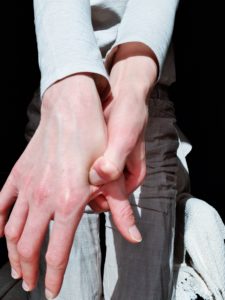
Large Intestine 4 *Contra-indicated in pregnancy*
Symptoms: Large Intestine 4 regulates the body’s immune system, promotes sweating (so has a detoxifying effect), and treats the onset of any acute illness. It’s good against colds, nasal congestion, headache, toothache, and hayfever. When used with Liver 3, it stops pain, and it can also be used together with Stomach 36 to boost the body’s defenses, and Qi energy.
Where to find it: It’s located between the thumb and first finger metacarpal bones (on the hand itself), around the middle of the 2nd bone.
How to work it:
Apply firm pressure with the thumb until you feel a tender spot. If it’s difficult to find, try slightly shifting the direction of the pressure.
10. Gall Bladder 30: Jumping Circle

Gallbladder 30 – don’t be shy!
Symptoms: Last, but definitely not least, Gall Bladder 30 is invaluable if you’ve been sitting down too long, and have a bit of soreness/achiness or numbness in your glutes. It facilitates circulation, treating pain, numbness and weakness in the lower back/hips/scarum/legs area, and is good for sciatica sufferers.
How to find it: At the joint of the hip and the femur, just round the back a little way from the side of the hips. Basically, it’s in the outer buttock region.
How to work it: This is an area with quite a lot of muscle and padding, so being delicate will not do anything! The way to work Gallbladder 30 is with loose fists, using percussive tapping, coming in from behind and outside the hips, towards the sacral area – in a diagonal movement. Don’t hit the point too hard, but equally don’t be timid. It’s just bliss after sitting after a computer or on a sofa for hours on end!
One thing I like to do when I use an acupressure point or another form of holistic treatment, is keeping a treatments journal, and logging before and after each session, grading the level of pain/discomfort or condition I’m looking to treat. That way it’s easy to see clearly whether there’s been any longer-term change over time, as well as at the time of the treatment.
Also by Ema: 6 Energy Protection Rituals To Reset Your Vibes
When Netflix Has Lost Its Charms—5 Best Board Games To Play In Lockdown
Get more like this—Sign up for our daily inspirational newsletter for exclusive content!
__
Photo: Ema Melanaphy




